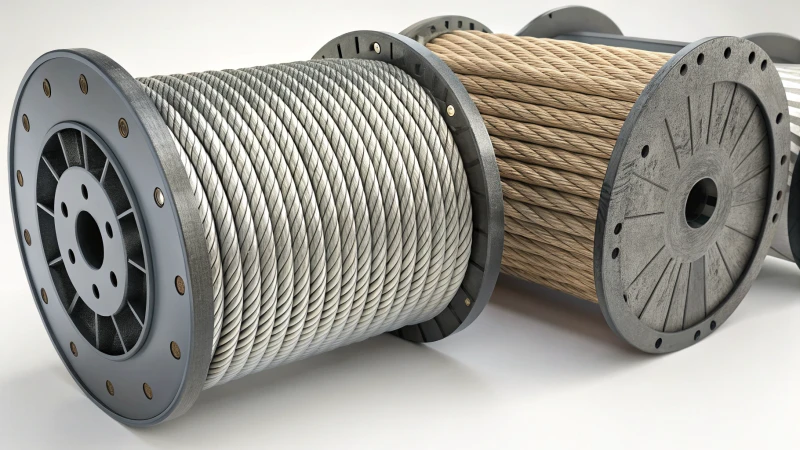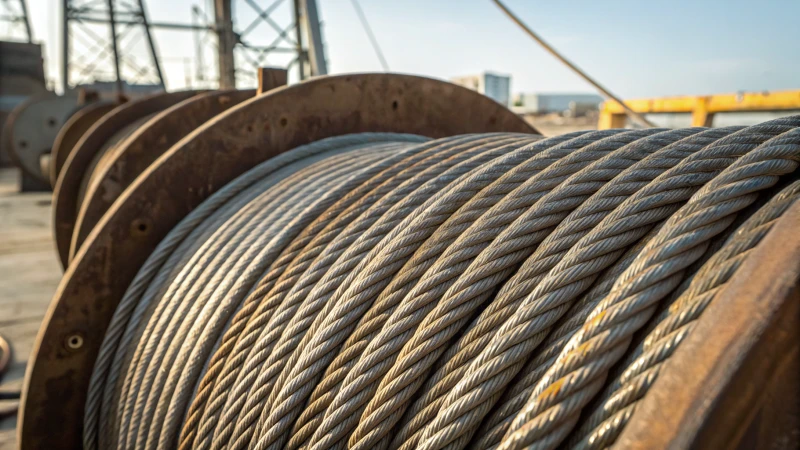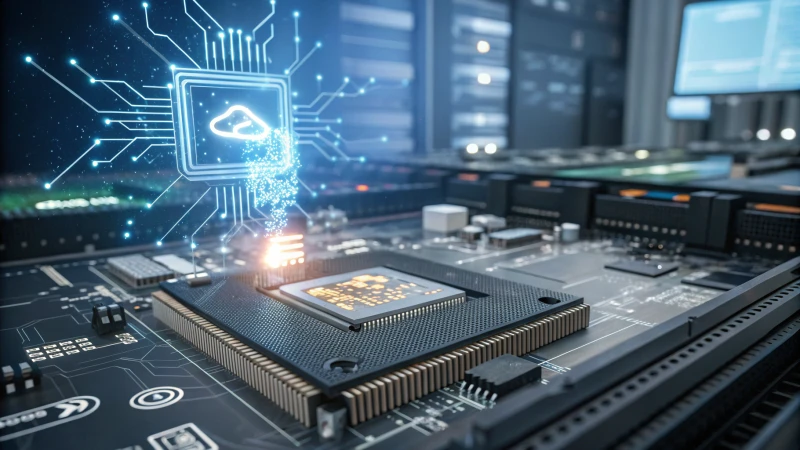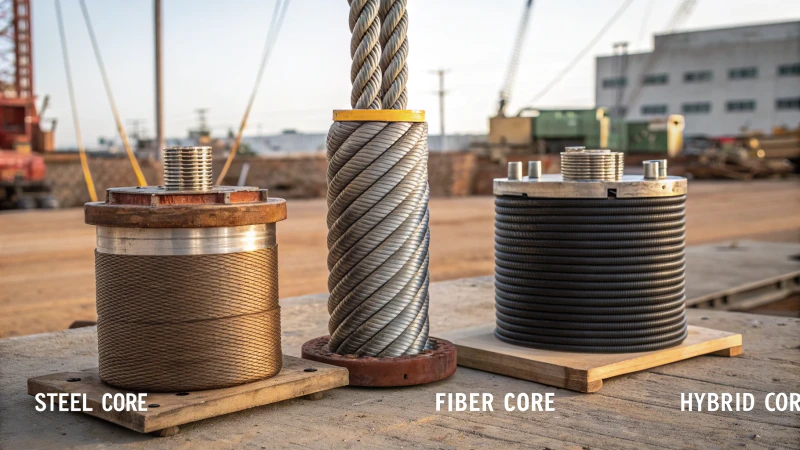
Have you ever wondered why choosing the right steel wire rope core is so crucial?
Steel wire rope cores are vital as they influence the rope's strength, flexibility, and crush resistance. The main types include steel, fiber, and hybrid cores. Steel cores offer maximum strength, fiber cores provide greater flexibility, and hybrid cores balance both for versatile uses.
I remember the first time I faced the daunting task of selecting the right steel wire rope for a major project. It felt like choosing the wrong core could make or break the entire operation. That's when I realized that understanding each core's characteristics—whether it's the robust strength of a steel core or the flexibility of a fiber core—wasn't just important; it was essential. Diving into the specifics of each type helped me make informed decisions, ensuring not only project success but also safety and efficiency. Let's explore these core types more deeply to grasp their unique advantages and challenges.
Steel cores provide maximum strength in wire ropes.True
Steel cores enhance tensile strength, making ropes suitable for heavy loads.
Fiber cores are more resistant to crushing than steel cores.False
Fiber cores offer flexibility but are less resistant to crushing compared to steel.
How Do Steel Cores Enhance Load Capacity in Wire Ropes?
Imagine lifting a car with a thread; impossible, right? But swap that thread for a wire rope with a steel core, and you can lift much more than a car!
Steel cores enhance load capacity by providing a strong and stable center that supports heavier loads and improves the rope's resistance to crushing and deformation, making them ideal for demanding applications.

The Mechanics of Steel Cores in Wire Ropes
I remember the first time I saw a construction crane in action. It was mesmerizing to see such a massive machine effortlessly lift heavy steel beams high into the sky. But what made it possible? The secret lies in the steel-core wire ropes, which serve as the backbone, maintaining shape and integrity under enormous pressure. Unlike fiber cores1 that offer flexibility, steel cores are all about strength and stability, especially crucial when working with colossal loads like those cranes handle.
Benefits of Steel Cores
- Higher Load-Bearing Capacity: It’s like having a safety net that’s 15% stronger than its counterparts made from fiber. This extra strength is indispensable in industries where I see towering cranes lifting unimaginable weights.
- Enhanced Crush Resistance: Picture this—outer strands of the rope collapsing under pressure if not for the robust steel core inside. It significantly extends the lifespan of the wire rope.
- Improved Heat Resistance: When I worked on offshore drilling projects, I noticed how the heat could quickly become an issue. Steel cores can withstand these temperatures, reducing failure risks in such heat-intensive environments like offshore drilling2.
| Feature | Steel Core | Fiber Core |
|---|---|---|
| Load Capacity | High | Moderate |
| Flexibility | Low | High |
| Heat Resistance | High | Moderate |
| Durability | High | Moderate |
Applications of Steel-Core Wire Ropes
Every time I pass a high-rise building under construction or hear about massive mining operations, I think about the steel-core wire ropes working tirelessly behind the scenes. These ropes are champions in handling abrasive conditions and heavy loads3. Elevators rely on them too—no wonder they’re known for reliability and strength!
Considerations for Use
However, there's a trade-off. While steel cores offer impressive load capacity, they sacrifice some flexibility. This can be a setback in dynamic applications where bending is frequent. Choosing the right core type is all about balancing load needs with flexibility. In my experience, hybrid cores—a mix of steel and fiber—sometimes offer the perfect solution in certain dynamic environments4. They bring out the best of both worlds, giving you strength and flexibility.
Steel cores increase wire rope load capacity by 15%.True
Steel cores enhance load capacity by approximately 15% compared to fiber cores.
Fiber cores offer higher heat resistance than steel cores.False
Steel cores provide higher heat resistance, unlike fiber cores, which are moderate.
Why Choose Fiber Cores in Wire Ropes?
Ever wondered why some wire ropes feel more adaptable and shock-absorbing?
Fiber cores in wire ropes enhance flexibility and vibration absorption, making them ideal for applications where these traits are more crucial than raw tensile strength. They also bolster fatigue resistance, perfect for dynamic environments.

Enhanced Flexibility
I remember the first time I watched a crane operator deftly maneuver a load across a bustling construction site. It was like watching a ballet of steel and precision. I asked the operator what made the crane so nimble, and he pointed to the fiber core wire ropes—remarking how they could twist and turn around pulleys without a hitch. These ropes bend easily, unlike their steel core counterparts, making them a dream for situations where you need to navigate around machinery or tight corners frequently, such as in construction sites5.
Vibration Absorption
In the throes of a mining operation, where heavy machinery vibrates with the power of a thousand engines, the importance of vibration absorption hits home. Picture this: a colleague once shared a story about how fiber core wire ropes helped reduce the stress on their machinery, ultimately saving them a bundle in maintenance costs. Fiber cores soak up those relentless vibrations, protecting both the rope and the equipment in industries like mining6.
Fatigue Resistance
If you've ever worked with materials that get worn out quickly, you know the frustration of constant replacements. That's where fiber cores shine—taking on repetitive bending and flexing without losing their edge. A friend in marine engineering swears by them, using these ropes for dynamic applications where constant motion is part of the job, such as in marine environments7.
| Feature | Fiber Core | Steel Core |
|---|---|---|
| Flexibility | High | Low |
| Vibration Absorption | Excellent | Poor |
| Fatigue Resistance | High | Moderate |
| Load-Bearing Capacity | Lower | Higher |
Cost Efficiency
Every penny counts, right? I’ve noticed that fiber-core wire ropes can be a bit easier on the wallet, primarily because they're cheaper to produce than steel-core versions. For businesses that need to keep an eye on expenses—like many I've worked with in logistics8—these ropes offer a financially sound option without sacrificing too much on performance.
Environmental Considerations
Let's talk green. The eco-warrior in me appreciates that many fiber cores come from natural sources like sisal or sustainable synthetics such as nylon. This makes them a better choice for industries aiming to shrink their carbon footprints—think renewable energy projects9.
Practical Application Insights
At the end of the day, choosing between fiber and steel cores boils down to what you need them for. Fiber cores are fantastic when flexibility and reduced fatigue are top priorities. However, if you need to lift massive weights, steel might still be your go-to. It's all about understanding your project's unique demands and making choices that align with your goals.
Fiber cores enhance wire rope flexibility over steel cores.True
Fiber cores are more flexible than steel, aiding in maneuverability.
Fiber-core ropes have higher load capacity than steel-core ropes.False
Steel-core ropes have a higher load-bearing capacity than fiber-core ropes.
Why Are Hybrid Cores Considered Ideal for Dynamic Applications?
Ever wondered why hybrid cores are the perfect match for dynamic applications? Let's dive into how they seamlessly balance power and efficiency to elevate performance.
Hybrid cores excel in dynamic applications by seamlessly balancing power efficiency and performance. They intelligently allocate resources between demanding and background tasks, enhancing system responsiveness and conserving energy.

Understanding Hybrid Cores
I remember the first time I heard about hybrid cores—it felt like a lightbulb moment. Hybrid core architecture cleverly combines performance cores (P-cores) and efficiency cores (E-cores) to juggle diverse workloads effortlessly. Performance cores10 are like the superheroes of computing, handling tasks like gaming or video editing with incredible speed. Meanwhile, efficiency cores11 tackle those everyday tasks, ensuring power isn't wasted.
Advantages of Hybrid Cores
-
Dynamic Workload Management
Imagine your computer as a bustling city. Hybrid cores are like the traffic managers, directing heavy tasks to P-cores and lighter ones to E-cores. This balance ensures everything runs smoothly, extending battery life and boosting performance.
Task Type Assigned Core Gaming P-core Video Editing P-core Email Syncing E-core -
Enhanced System Responsiveness
Picture this: you're on your phone, switching from watching a high-definition video to checking emails. Hybrid cores make this transition feel seamless, minimizing lag and enhancing your experience.
-
Improved Power Efficiency
In the world of dynamic applications, where resource needs can shift dramatically, hybrid cores cut down on power waste. This is a game-changer for mobile devices where every drop of battery counts.
Applications Benefiting from Hybrid Cores
- Mobile Devices: Smartphones and tablets thrive on hybrid cores to maintain that sweet spot between power and battery life.
- Laptops: They use hybrid architecture to deliver peak performance for demanding software while conserving energy during downtime.
- Embedded Systems: From smart TVs to home assistants, these devices leverage hybrid cores to balance performance with energy efficiency.
Understanding dynamic applications12 in today's tech landscape highlights why hybrid cores have become essential in both consumer gadgets and industrial tools. They aren't just about keeping up—they're about setting the pace.
Hybrid cores enhance battery life in mobile devices.True
Hybrid cores allocate tasks to efficiency cores, reducing power usage.
Performance cores handle all tasks in hybrid architecture.False
Efficiency cores manage lighter tasks, while performance cores handle demanding ones.
How do I select the right wire rope core for my project needs?
Ever found yourself standing amidst a construction site, staring at a spool of wire rope, wondering which core type is right for the job? You're not alone.
To choose the right wire rope core, consider your project's load requirements, environmental conditions, and flexibility needs. Steel cores provide unmatched strength, fiber cores offer superior flexibility, and hybrid cores blend both for a balanced performance.

Understanding Wire Rope Core Types
Ah, the world of wire rope cores—it's like choosing the perfect ingredient for a recipe that determines the safety and success of your project. I remember my first big procurement job, feeling overwhelmed by the options. Let's break it down:
| Core Type | Key Benefits | Typical Use |
|---|---|---|
| Steel Core | High tensile strength and crush resistance | Construction cranes |
| Fiber Core | Enhanced flexibility and vibration absorption | Mining equipment |
| Hybrid Core | Balanced strength and flexibility | Dynamic applications |
Steel Wire Rope Cores
Steel cores were my go-to when I managed a massive crane operation. We needed ropes that wouldn’t buckle under heavy loads. They’re like the bodybuilders of wire ropes—strong, reliable, but maybe not the most flexible.
- Pros: High load capacity, superior resistance to crushing.
- Cons: Reduced flexibility, increased weight.
Fiber Wire Rope Cores
Then there were times when we needed something more agile. Fiber cores, with their lightweight nature and ability to absorb shocks, felt like a revelation. Picture them as the gymnasts of the wire rope world.
- Pros: Lightweight, high flexibility.
- Cons: Lower tensile strength compared to steel cores.
Hybrid Wire Rope Cores
When I was tasked with an offshore project, hybrid cores were our heroes. They handled the bending and stress like seasoned pros. It was like having the best of both worlds!
- Pros: Enhanced fatigue life, balanced properties.
- Cons: Can be more expensive than single material cores.
Factors Influencing Core Selection
Selecting a wire rope core is more than just ticking boxes. It's about understanding your needs deeply:
- Load Requirements: In one of my projects, underestimating this led to delays. Always gauge the weight your rope will bear.
- Flexibility Needs: If the rope must dance through tight spots or endure frequent bending, go for fiber.
- Environmental Conditions: For extreme conditions, hybrids can withstand salt and moisture better.
Explore detailed specifications13 from industry standards to guide you further. And never hesitate to consult a wire rope expert14 who can tailor advice specifically for you.
By weighing these factors carefully, you ensure your choice enhances safety and efficiency. Trust me, making the right decision will save you from headaches down the line.
Steel cores have high tensile strength.True
Steel cores are known for their high load capacity and crush resistance.
Fiber cores are heavier than steel cores.False
Fiber cores are lightweight, offering flexibility and vibration absorption.
Conclusion
Steel wire rope cores, including steel, fiber, and hybrid types, significantly impact strength, flexibility, and durability. Choosing the right core is essential for safety and performance in various applications.
-
Explore differences between fiber and steel cores to understand their unique advantages and limitations. ↩
-
Learn why steel core ropes are preferred for offshore drilling due to their heat resistance. ↩
-
Discover why steel-core ropes excel in mining operations due to their high load capacity. ↩
-
Find out how hybrid cores offer a balance of strength and flexibility in dynamic settings. ↩
-
Explore how flexible wire ropes enhance efficiency in construction projects by allowing easier maneuverability around equipment. ↩
-
Discover how fiber-core ropes reduce machinery wear through vibration absorption in mining operations. ↩
-
Learn why fiber-core wire ropes are preferred in marine environments due to their fatigue resistance. ↩
-
Understand how using fiber-core ropes can lead to cost savings in logistics operations. ↩
-
Find out how fiber-core ropes contribute to sustainability efforts in renewable energy sectors. ↩
-
Discover how performance cores handle intensive tasks, ensuring maximum processing power and speed. ↩
-
Learn how efficiency cores optimize less demanding tasks, contributing to energy savings. ↩
-
Understand the role of hybrid cores in enhancing system responsiveness and efficiency in diverse applications. ↩
-
Provides in-depth specifications that help in making an informed decision about wire rope selection. ↩
-
Offers expert advice tailored to specific project needs, enhancing decision-making for wire rope selection. ↩

